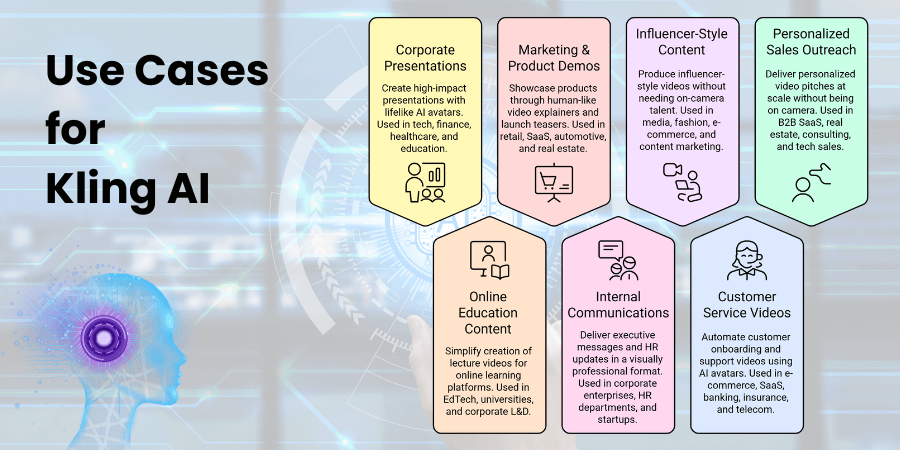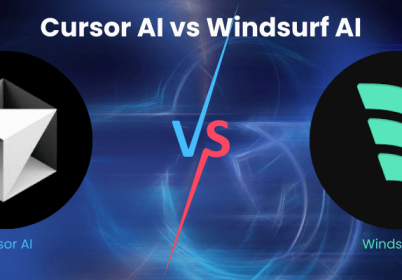How to Use Kling AI: Complete Guide to Creating Stunning Videos with Artificial Intelligence
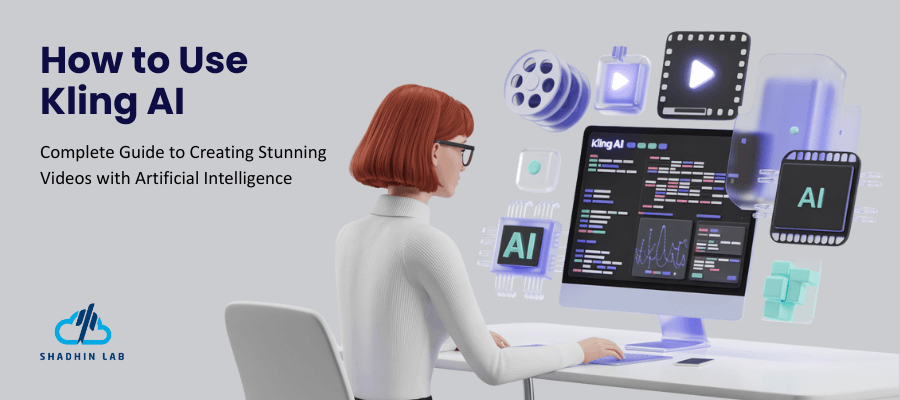
Table of Contents
Artificial Intelligence video generation tools have transformed how we create content across numerous industries today. These innovative technologies make high-quality video production accessible without requiring extensive technical expertise or expensive equipment investments. Learning how to use Kling AI has become essential as this platform emerges among the leading solutions in AI video creation. The remarkable accessibility and impressive results drive growing popularity among businesses and individual creators seeking professional-quality videos. This comprehensive guide explores how to use Kling AI effectively for enhancing your video creation workflow and capabilities. We will examine the platform’s standout features, provide a detailed step-by-step usage guide, and highlight practical applications across various professional contexts. Understanding how to use Kling AI properly can dramatically improve your content creation efficiency while delivering polished, engaging videos for your audience.
Key Takeaways
- Kling AI turns text or images into high-quality videos using advanced AI, ideal for users without video editing skills.
- It offers powerful features like text-to-video, image-to-video, camera control, batch generation, and realistic motion rendering.
- Using Kling AI is simple: Sign up, input prompts, adjust creativity settings, and generate videos with professional results.
- Prompt quality directly impacts output — specific, well-structured, and vivid prompts lead to more accurate and engaging videos.
- Kling supports many use cases such as corporate presentations, education, marketing, internal comms, customer service, and sales.
- Flexible pricing with credits makes it accessible for casual users, professionals, and large teams needing high-volume content creation.
Table of Contents
What is Kling AI?
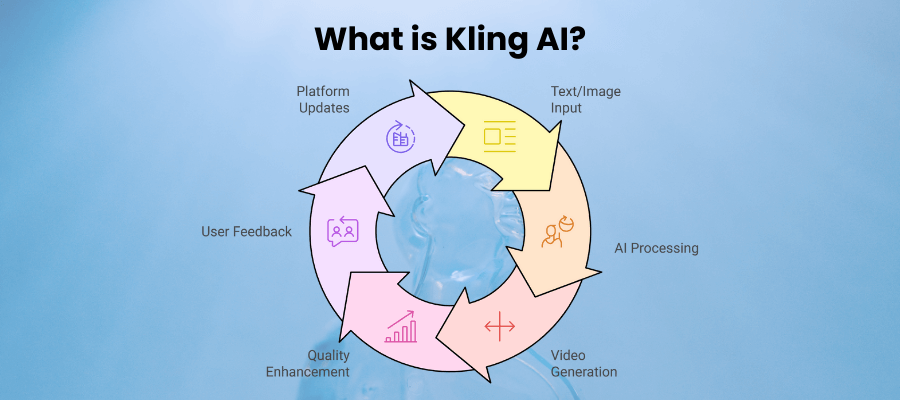
Kling AI represents a cutting-edge text-to-video and image-to-video generation platform powered by sophisticated artificial intelligence algorithms. The system transforms simple text descriptions or static images into dynamic, realistic video content through advanced deep learning models. Kling AI operates within the expanding ecosystem of generative AI tools that continue reshaping creative workflows across numerous professional fields. The platform distinguishes itself through exceptional video quality and remarkably realistic motion rendering that surpasses many competing solutions. Users particularly appreciate how Ling AI excels in creating smooth transitions and natural movements that avoid the awkward artificiality common in AI-generated content. The intuitive interface simplifies complex video generation processes for users regardless of their technical background or experience level. Advanced scene understanding technology maintains impressive contextual consistency throughout the generated video sequences for professional-looking results. The platform continues evolving through regular updates that expand creative possibilities and enhance output quality for creators at every skill level.
Key Features of Kling AI
Kling AI offers a comprehensive suite of features designed to empower creators with versatile video generation capabilities:
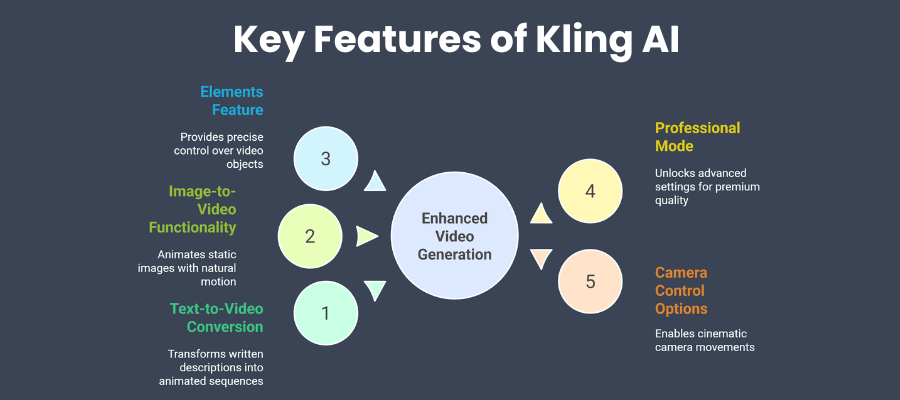
- The text-to-video conversion system transforms written descriptions into fully animated sequences with remarkable accuracy and visual fidelity
- Image-to-video functionality animates static photographs or artwork with natural motion that respects the original composition
- The Elements feature provides precise control over specific objects and characters within generated videos for detailed customization
- Professional mode unlocks advanced settings for experienced users seeking premium quality outputs and greater creative flexibility
- Camera control options enable specific movement directions like panning, zooming, and tracking for truly cinematic results
The creativity slider adjusts the balance between strict prompt adherence and artistic interpretation in the final video output. Negative prompts allow users to explicitly exclude unwanted elements or visual styles from appearing in their generated content. Frame interpolation technology creates exceptionally smooth transitions between scenes without jarring movements or visual artifacts. Various resolution options accommodate different distribution channels and quality requirements based on your specific project needs. Batch processing capabilities enable efficient creation of multiple related videos using similar parameters or systematic prompt variations.
How to Use Kling AI Video Generator: Step-by-Step Guide
Creating your account marks the essential first step toward using Kling AI effectively for video generation. Visit the official Kling AI website and locate the prominently displayed registration button to begin the signup process. Enter your preferred email address, create a secure password, and complete any additional verification steps required by the platform.
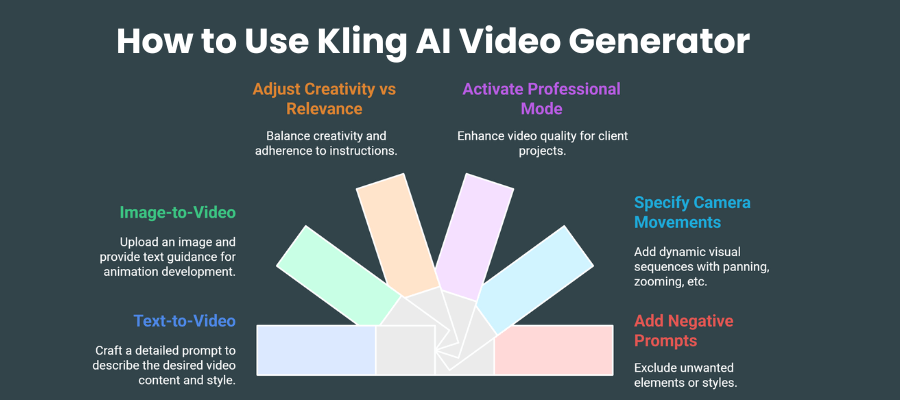
Most new users receive complimentary credits immediately after registration to begin experimenting with the platform’s capabilities right away. After successful login, take time to explore the dashboard interface and navigation elements for building an efficient workflow.
The main video creation workflow follows these fundamental steps:
- Choose between text-to-video or image-to-video generation based on your specific project requirements and starting materials
- For text-to-video, craft a detailed prompt describing your desired video content, visual style, and movement patterns
- For image-to-video, upload your source image and provide additional text guidance for how the animation should develop
- Adjust the creativity versus relevance slider according to how closely you want the output to follow your instructions
- Consider activating Professional mode for significantly higher quality results when working on important client projects
- Specify any desired camera movements such as panning, zooming, or tracking to create more dynamic visual sequences
- Add negative prompts to explicitly exclude any unwanted elements or styles from appearing in your generated video
Click the generate button and allow sufficient processing time for the AI to create your video with care. Review the completed video thoroughly and note which elements worked well or require adjustment in future generations. Download your finished video in your preferred resolution format for immediate use in your projects or marketing campaigns.
Pricing of Kling AI
| Plan | Monthly Cost | Credits Included | Features | Best For |
| 無料の | $0 | 15 credits | Basic video generation, Standard quality, Limited resolution options | Beginners, Casual users, Testing the platform |
| Basic | $29 | 125 credits | Standard and Professional modes, Higher resolution options, Faster generation | Content creators, Small businesses, Regular users |
| Pro | $79 | 400 credits | All generation modes, Priority processing, Advanced camera controls, Higher resolution | Professional creators, Marketing teams, Agencies |
| Enterprise | Custom pricing | Custom allocation | Dedicated support, API access, Custom model training, Volume discounts | Large organizations, High-volume users, Custom implementations |
Credit consumption varies based on which specific features you utilize during each video generation session. Standard mode typically requires between 5-10 credits per video depending on length and overall complexity. Professional mode consumes 15-25 credits per video but delivers significantly higher quality results worth the additional investment. Additional credits remain available for purchase separately without changing your subscription tier for maximum flexibility. The platform occasionally offers special promotional discounts or bonus credit allocations for new users or during seasonal events. Enterprise customers receive fully customized pricing structures based on their specific usage requirements and anticipated volume needs.
Best Prompts to Use with Kling AI
Creating effective prompts dramatically impacts the quality and accuracy of videos generated through Kling AI. Specificity forms the foundation of successful prompts, with detailed descriptions consistently yielding more precise and satisfying results. Include clear information about settings, characters, actions, lighting conditions, and camera perspectives in your carefully crafted prompts. Maintain logical structure by organizing your prompt elements from the most important components to supporting contextual details. Begin with the main subject and primary action, then add environmental elements like setting, time of day, and stylistic preferences.
Descriptive language significantly enhances results, so incorporate vivid adjectives that clearly communicate visual qualities and atmospheric elements. Consider referencing specific art styles or cinematographic techniques to guide the aesthetic direction of your generated video. Avoid ambiguous instructions or contradictory elements that might confuse the AI and produce unpredictable or disappointing results. Technical specifications often improve output quality, so mention desired resolution, aspect ratio, and frame rate when particularly relevant.
Effective prompt examples include:
- “A photorealistic astronaut walking slowly on Mars, red dusty landscape, Earth visible in sky, dramatic cinematic lighting”
- “Animated watercolor style forest with golden sunlight streaming through tall trees, gentle breeze moving leaves, wide angle view”
- “Close-up of confident middle-aged woman with auburn hair smiling warmly at camera, modern office setting, soft natural lighting”
Use Cases for Kling AI
Kling AI helps users create video content quickly and professionally. It works well for both individuals and businesses. You do not need a camera or real presenter. Its lifelike AI avatars make communication easy and effective. Here are some common ways people use Kling AI.
1. Corporate Presentations
Kling AI is a powerful tool for creating high-impact corporate presentations with lifelike AI avatars.
Industries Served:
Used widely in tech, finance, healthcare, and education for boardroom pitches, training, and investor decks.
How It Works:
Users input a script and select an avatar; Kling renders a hyper-realistic presenter delivering the message naturally.
Impact:
Reduces reliance on video crews and presenters. Speeds up production while maintaining a polished professional tone.
Real-World Example:
A fintech startup used Kling AI to deliver investor updates featuring a consistent virtual CEO avatar, enhancing brand trust.
2. Online Education Content
Kling AI simplifies the creation of lecture videos and explainer content for online learning platforms.
Industries Served:
EdTech, universities, coaching institutes, and internal corporate L&D teams.
How It Works:
Teachers or trainers upload lesson scripts. Kling transforms them into videos with digital tutors that mimic real human gestures.
Impact:
Saves hours of recording and editing. Ensures engaging delivery across multilingual, multicultural student bases.
Real-World Example:
An Indian e-learning platform used Kling to roll out 100+ courses in 3 languages in under 2 weeks.
3. Marketing & Product Demos
Kling AI helps brands showcase their products through human-like video explainers and launch teasers.
Industries Served:
Retail, SaaS, automotive, real estate, and consumer electronics.
How It Works:
Marketers upload a product script, choose a tone and avatar, and Kling generates a compelling demo or announcement video.
Impact:
Boosts engagement across social media and landing pages. Cuts video production costs by up to 70%.
Real-World Example:
A SaaS company used Kling to create multilingual product demos, increasing their landing page conversion rate by 32%.
4. Internal Communications
Kling AI delivers executive messages and HR updates in a visually professional, personalized format.
Industries Served:
Corporate enterprises, HR departments, startups, and distributed teams.
How It Works:
HR managers upload message scripts, and Kling creates a video featuring an AI avatar delivering the update in a friendly tone.
Impact:
Strengthens internal engagement and keeps distributed teams aligned without needing live Zoom sessions.
Real-World Example:
A hybrid IT firm used Kling to share weekly updates via AI avatars, increasing internal content views by 45%.
5. Influencer-Style Content Creation
Kling AI empowers individuals and brands to produce influencer-style videos without needing on-camera talent.
Industries Served:
Media, fashion, e-commerce, personal branding, and content marketing.
How It Works:
Creators script their content, select a relatable AI avatar, and Kling generates short-form or long-form videos for social platforms.
Impact:
Accelerates content production for YouTube, TikTok, and Instagram. Ideal for those who want quality without being on camera.
Real-World Example:
A solo entrepreneur used Kling AI to post weekly lifestyle tips via an avatar host, gaining 25K followers in two months.
6. Customer Service Videos
Kling AI automates customer onboarding and support videos using conversational AI avatars.
Industries Served:
E-commerce, SaaS, banking, insurance, and telecom.
How It Works:
Support teams feed Kling with FAQs or onboarding scripts. It generates helpful videos using friendly, customizable avatars.
Impact:
Reduces pressure on live agents. Enhances customer experience with 24/7 support in multiple languages and tones.
Real-World Example:
An online insurance provider used Kling to create explainer videos for policy terms, cutting ticket volume by 38%.
7. Personalized Sales Outreach
Kling AI enables sales teams to deliver personalized video pitches at scale without being on camera.
Industries Served:
B2B SaaS, real estate, consulting, and enterprise tech sales.
How It Works:
Sales reps upload outreach scripts with dynamic variables. Kling produces tailored video pitches with professional avatars.
Impact:
Boosts reply rates and builds trust faster than text emails. Ideal for cold outreach and follow-ups.
Real-World Example:
A real estate firm used Kling to send personalized listing pitches to 500 leads, doubling their response rate in one week.
Common Issues and Solutions When Using Kling AI
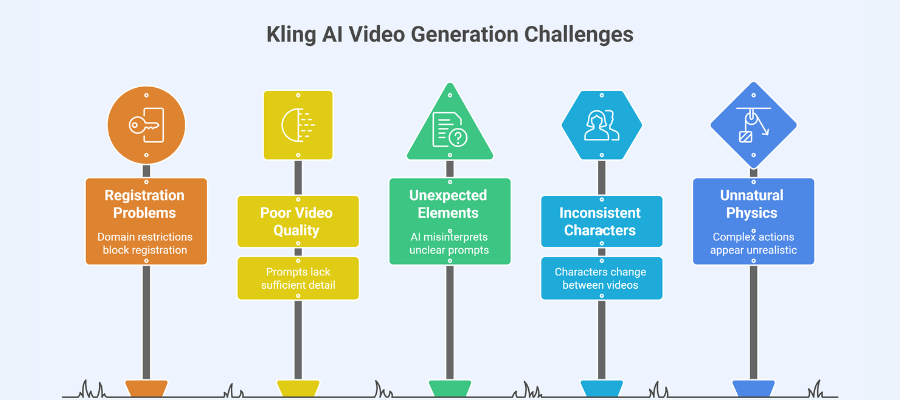
Users occasionally encounter registration problems stemming from email domain restrictions or verification message delivery issues. The solution typically involves using alternative email providers or directly contacting customer support for prompt assistance with account creation. Video quality sometimes falls below expectations when prompts lack sufficient detail or contain ambiguous instructions. Improving prompt clarity and adding specific visual references usually resolves this issue effectively for better results. Unexpected objects or elements may appear in generated videos due to AI misinterpretation of unclear or contradictory prompts.
Common challenges and their practical solutions include:
- Character consistency issues across multiple related videos – Create and save custom character models for important recurring figures
- Unnatural physics in complex action sequences – Simplify scene complexity or break complicated actions into separate connected videos
- Slow generation times during high-demand periods – Schedule important project work during off-peak platform usage hours
- Rapid credit depletion when using advanced features – Plan projects carefully and batch similar video requests together for efficiency
- Jarring camera movements in finished videos – Start with subtle movement directions before attempting more complex cinematography
Conclusion
Kling AI represents a truly transformative tool in the rapidly evolving landscape of modern content creation technology. The platform successfully democratizes professional video production by making high-quality content accessible to creators regardless of technical expertise or budget limitations. Understanding how to use Kling AI effectively unlocks remarkable potential for businesses and individuals seeking innovative visual communication methods that resonate with audiences.
The thoughtful combination of intuitive interface design and powerful AI capabilities positions Kling AI as an invaluable asset in contemporary content strategies. As AI video generation technology continues advancing, early adopters gain significant competitive advantages in their respective professional fields. The diverse applications across industries clearly demonstrate the platform’s versatility and broad relevance to modern communication needs. Ongoing improvements to the underlying algorithms promise even more impressive capabilities in future versions of this innovative platform.
Exploring Kling AI represents a worthwhile investment for forward-thinking creators looking to enhance their visual storytelling toolkit with cutting-edge technology. The careful balance between user accessibility and sophisticated output makes Kling AI particularly valuable as platform access continues expanding. We encourage readers to experiment with the techniques outlined in this guide to discover the full potential of AI-powered video creation.
Frequently Asked Questions
Is Kling AI suitable for beginners with no video production experience?
Yes, Kling AI features an exceptionally intuitive interface designed specifically for users without technical video production knowledge. The text-based prompt system allows anyone to generate impressive videos by simply describing what they want to see. The platform automatically handles all technical aspects of video creation without requiring specialized expertise.
How long does it take to generate a video with Kling AI?
Generation time typically ranges from 2-5 minutes for standard videos depending on length, complexity, and current platform demand. Professional mode videos may require additional processing time due to the higher quality output and more sophisticated rendering requirements.
Can I edit videos after Kling AI generates them?
Kling AI does not include built-in editing features for videos after generation is complete. Users should download their videos and use external video editing software for additional modifications, cuts, or enhancements to the AI-generated content.
Does Kling AI offer copyright-free videos for commercial use?
Yes, videos generated through Kling AI can be used commercially without copyright concerns or attribution requirements. The platform grants users full usage rights to their generated content for both personal and business applications across all subscription tiers.
How can I improve the quality of faces in Kling AI videos?
Include detailed descriptions of facial features in your prompts and consider using reference images when available. Professional mode typically produces significantly better facial details and natural expressions compared to standard mode. Avoid requesting extreme facial close-ups, as wider shots often yield more natural-looking results.
Shaif Azad
Related Post
Best Leonardo AI Alternatives in 2025: Find the Right AI Art Tool for Your Needs
New York City has rapidly emerged as one of the world’s most dynamic hubs for technology...
Top AI Software Development Companies in NYC: Your Guide to Smart AI Partnerships
New York City has become one of the most exciting hubs for technology and artificial intelligence....
Cursor AI vs Windsurf AI: The Future of AI-Powered Code Editors in 2025
The landscape of software development has undergone a remarkable transformation in 2025, with AI-powered code editors...

